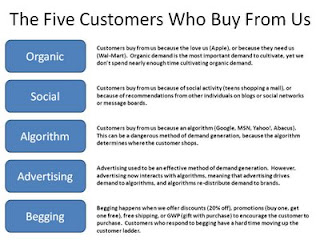Much of the segmentation/modeling/planning process involves predicting a future purchase, followed by the determination of an appropriate targeting strategy.For instance, in this catalog example, we predict two things.- We predict the Response Rate to a future catalog.
- We predict the Average Order Size for a segment being mailed a future catalog.
Based on these two predictions, and a forecast for the cost of mailing a catalog, we arrive at the following segment-level mailing prediction and profit/loss statement (after online/retail matchback):
| Prediction |
| Response Rate | 1.8% |
| Avg. Order | $125.00 |
| $ Per Book | $2.25 |
| Flow-Through % | 35.0% |
| Flow-Through $ | $0.79 |
| Book Cost | $0.70 |
| Profit | $0.09 |
The marketing world of 2009 requires a different level of sophistication.In the future, we will change the planning and prediction process. This segment will be split into two sub-segments.- Subsegment #1 = Customers with the same RFM-style classification, but never historically purchased using Paid Search, Affiliates, or Shopping Comparison Sites.
- Subsegment #2 = Customers with the same RFM-style classification, but historically purchased using Paid Search, Affiliates, or Shopping Comparison Sites.
In each case, we'll measure future response, but we'll also predict the expected marketing cost associated with self-service customers using Paid Search, Affiliates, or Shopping Comparison Sites. If the catalog or e-mail drives customers to these micro-channels, we incur additional marketing expense. Here's the sub-segment prediction:
| Subseg #1
| Subseg #2
|
| Response Rate | 1.8% | 1.8% |
| Avg. Order | $125.00 | $125.00 |
| $ Per Book | $2.25 | $2.25 |
| Flow-Through % | 35.0% | 35.0% |
| Flow-Through $ | $0.79 | $0.79 |
| Book Cost | $0.70 | $0.70 |
| Pred. Search/Aff/SC Cost | $0.02 | $0.18 |
| Profit | $0.07 | ($0.09) |
In this example, Subsegment #2 generates additional expense, because they like to use Paid Search, Affiliates, and Shopping Comparison sites after receiving a catalog. Therefore, we have to predict what the amount of incremental expense is likely to be. The same level of prediction is required to properly manage future e-mail campaigns.
For Statistical Modelers, this opens up a whole new area of exploration --- it's like drilling for oil in areas where exploration was prohibited.
For the Catalog Circulation Director, this gives you the opportunity to fundamentally change the contact strategy for self-service online shoppers, while generating a boatload of profit for your brand.
For the E-Mail Marketer, you have a once-in-a-lifetime chance to motivate your Executive team to deliver e-mail campaigns to unprofitable customers less often --- and you'll have the proof!
For the vendor community, especially for matchback vendors, you have a whole new product you can develop --- one that integrates purchases and expenses in a holistic and actionable manner. Or maybe the folks at Coremetrics or Omniture can get a jump on the catalog vendor community, and take ownership of this new opportunity.
Best of all, all of you e-mail vendor employees who regularly read this blog have a chance to build an application that improves the profitability of e-mail marketing efforts for your clients --- a good thing!!!Labels: Matchback, Modeling, Planning, segmentation













